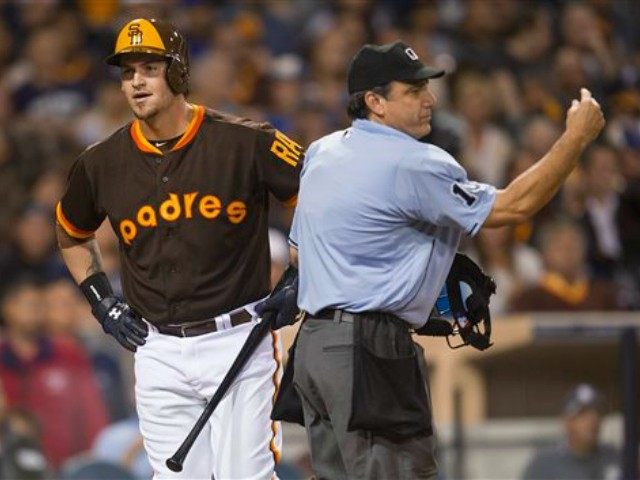The swelling of the invisible polyhedron above the white irregular pentagon has resulted in a shrinking of scoreboard totals. That’s at least the way baseball nerds see it.
Major League Baseball explores the possibility of reducing its strike zone, an area traditionally defined more expansively in the rulebook than on the field. But with pitch-tracking technology shaming umps into calling strikes for pitches they once called balls, the imaginary cuboid above the plate has ballooned. Stats wizards blame that growing strike zone for a relatively barren period offensively.
“Concern around baseball about the strike zone filtered down to the MLB’s Playing Rules Committee, which must formally adopt a rules change before it’s implemented,” Jeff Passan reports at Yahoo Sports. “The committee will pay close attention to the size of the strike zone in 2015 with an eye on change as early as 2016 after studies showed it has expanded significantly since 2009, coinciding with a precipitous dip in run scoring. Of particular concern, sources said, is the low strike, a scourge not only because it has stretched beyond the zone’s boundaries but is considered a significantly more difficult pitch to hit.”
Passan overlooks the 250-pound Cuban in the room. He omits any mention of the role of steroids and other performance enhancing drugs in boosting offense prior to this fallow period, which certainly experiences fewer runs in large part because fewer players juice because of more stringent testing protocols and stricter penalties for malefactors. It’s no longer the era of Lou Ferrigno in cleats but of Pablo Sandoval, Dustin Pedroia, Jimmy Rollins, and other players who don’t look like they would be very good at basketball, football, or any other sport save for this unique American game whose popularity stems in part from its universality. The players look like us rather than better than us.
Last season’s 8.14 runs per game trailed every season’s plate production since 1980. To put it in perspective, every season from 1993 through 2009 witnessed runs exceed nine per game. Prior to MLB lowering the mound in 1969, games in the pitchers’ decade of the 1960s witnessed fewer than eight runs per game during five seasons. Since the steroid-era peak 10.28 runs per game in 2000, runs have steadily declined before a precipitous drop after 2009.
MLB’s Rule 2.00 currently reads: “The STRIKE ZONE is that area over home plate the upper limit of which is a horizontal line at the midpoint between the top of the shoulders and the top of the uniform pants, and the lower level is a line at the hollow beneath the kneecap. The Strike Zone shall be determined from the batter’s stance as the batter is prepared to swing at a pitched ball.”
Whereas football legislators move goalposts, introduce the forward pass, and change the shape and size of the ball, baseball remains a more traditional game in which rulemakers hesitate to make even minor alterations. But a strike zone change would not come without precedent.
In the late 19th century, baseball repealed the rule that allowed batters to call for “high,” “low,” or “fair” pitches that created a more individualized strike zone for those wielding the wood. At the outset of the 1960s, in response to Roger Maris rewriting the record books, rules gurus rewrote the rule book. Then in 1969, after a season in which just one American League batsman, Carl Yastrzemski, hit above .300, the rulebook saw the strike zone expand. In 1996, MLB expanded the zone from the top of the knee cap to the bottom of it. Proponents of the shrinking strike zone hope their idea will do for offense what lowering the mound and the expansion of the strike zone did for it after 1968’s Year of the Pitcher.
Just a few years removed from a home-run-happy age that inspired wild charges of a juiced ball and more accurate charges of juiced players, baseball aficionados want to inflate run production to the levels they previously decried as inflated. The about-face reflects a short-sighted traditionalism that ultimately undermines the preservation it seeks coupled with a view constantly compromised by the dollar signs always in view.
The latter view grasps that all but four Major League teams set attendance records during the steroid era, amorphously defined here as starting during Jose Canseco’s MVP season and concluding around the time of Manny Ramirez’s initial performance-enhancing drug suspension. Its proponents vote for a run-happy game because fans vote for it with their remote controls and wallets. The former view reflexively reacts to each new change as though an existential threat to the game. It’s proponents don’t seem to grasp that the current change corrected a previous distortion instead of unleashing a new one.
Alas, it’s baseball, a game for the patient and persistent willing to endure failure in the batter’s box two in every three turns for the opportunity to eventually achieve success. More so than tinkerers obsessed with money or tinkerers obsessed with purity, the game faces its greatest challenge from an in-an-instant generation weaned on home-run highlights and a trophies-for-every mindset. A game that sees its best sluggers strike out four times for every at bat they send a ball over the fence may demand much more than shaving a few inches off the strike zone to again make baseball the national pastime.

COMMENTS
Please let us know if you're having issues with commenting.